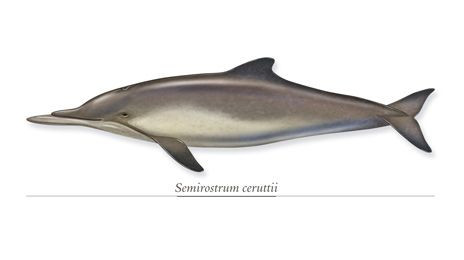Nice Underbite, Flipper: Ancient Porpoise Had Giant Chin, Probably Used It To Root Around For Food

An extinct porpoise that lived 1.5 million to 5.3 million years ago off the coast of what is now California had a chin that would put Jay Leno to shame.
Newly discovered species Semirostrum ceruttii is described in a paper published on Thursday in the journal Current Biology. The team of researchers that analyzed the fossil – found at a construction site in San Diego – think it probably used its massive lower jaw to root around in sediment on the ocean floor to rustle up its dinner. That sets it apart from modern porpoises (close relatives of dolphins), who prefer to hunt their prey above the seabed.
S. ceruttii’s closest living relatives are crown porpoises, which typically have a symphysis (basically, the animal analogue to a chin) of about 1 centimeter (.4 inches) in length. S. ceruttii, by comparison, has an 85 cm-long (33 inches) symphysis.
"This is unique anatomy for a mammal," lead author and Yale University researcher Rachel Racicot said in a statement on Thursday. "And it tells us that porpoises once searched for food in a very different way than they do now."
The probing method of searching for food is analogous to similar hunting techniques employed by modern skimmer birds. These kinds of birds, in the genus Rynchops, sport an uneven beak, akin to S. ceruttii’s jaw, where the lower mandible juts out beyond the upper mandible. To hunt, a skimmer will fly above the surface of water with its lower beak held just under the water, all the better to scoop up a fishy meal. There’s also an analogous jaw structure in half-beak fish (from the family Hemiramphidae).
When Racicot and colleagues examined fossil specimens of S. ceruttii with a CT scanner, they found nerve canals leading from the symphysis to the back of the animal’s skull. So it’s highly likely that the ancient porpoise’s protruding lower jaw was touch-sensitive – important if you’re going to use it to dig for food. (Skimmer birds also have extensive nerve connections running from the lower mandible to the brain.)
However, S. ceruttii’s protruding jaw probably wasn’t used to scoop up the food that it probed for.
“The transversely thin, blade-like shape of the mandible does not seem conducive to scooping or specialized biting… but prey may have rolled up the [lower jaw] during a kind of skimming followed by clamping of the lower jaw after encountering prey,” the authors wrote. “The streamlined mandible may have eased forward aquatic movement, with the head angled downward to monitor (via echolocation) and probe (via the mandible) for prey at the seafloor.”
SOURCE: Racicot et al. “Unique Feeding Morphology in a New Prognathous Extinct Porpoise from the Pliocene of California.” Current Biology published 13 March 2014.
© Copyright IBTimes 2024. All rights reserved.




















